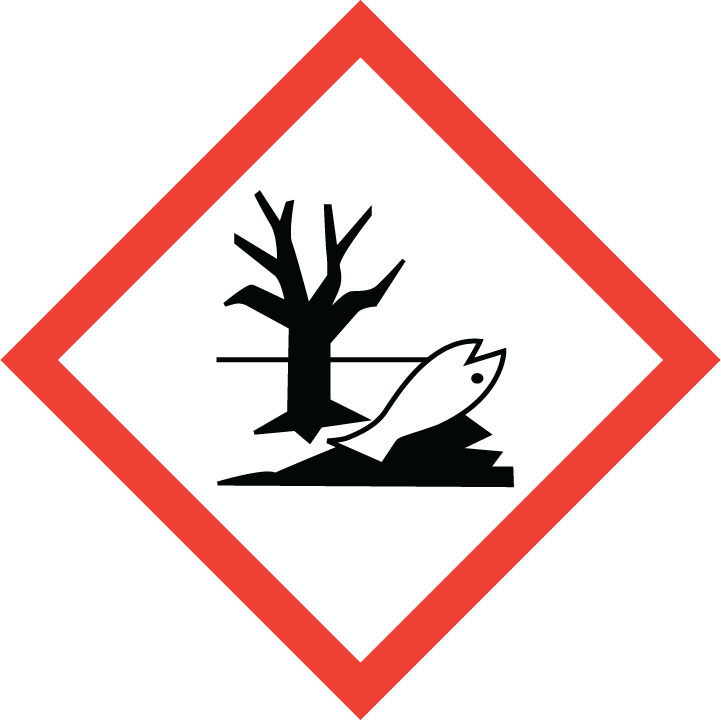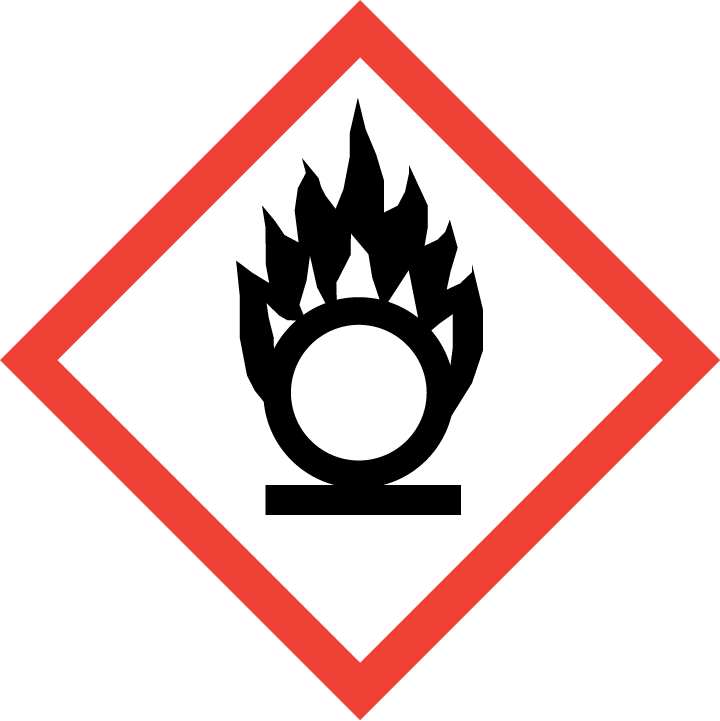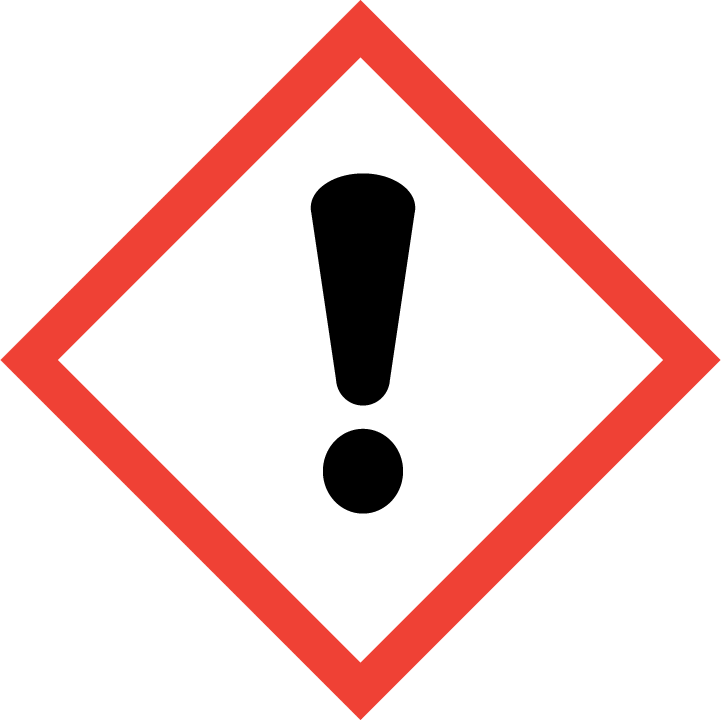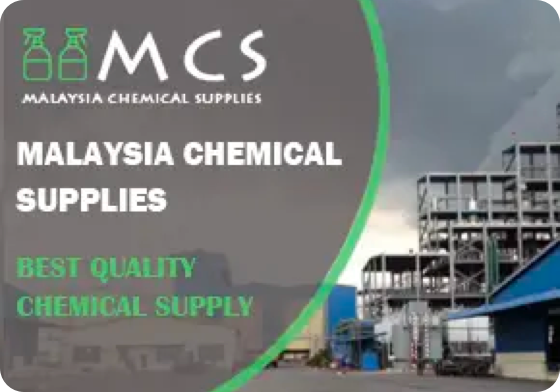1.Identification
1.1 GHS Product identifier
| Product name | Calcium Hypochlorite |
|---|
1.2 Other means of identification
| Product number | - |
|---|---|
| Other names | Hypochlorous acid calcium salt |
1.3 Recommended use of the chemical and restrictions on use
| Identified uses | For industry use only. Disinfectant |
|---|---|
| Uses advised against | no data available |
1.4 Supplier's details
| Company | MOLBASE (Shanghai) Biotechnology Co., Ltd. |
|---|---|
| Address | Floor 4 & 5, Building 12, No. 1001 North Qinzhou Road, Xuhui District, Shanghai, China |
| Telephone | +86(21)64956998 |
| Fax | +86(21)54365166 |
1.5 Emergency phone number
| Emergency phone number | +86-400-6021-666 |
|---|---|
| Service hours | Monday to Friday, 9am-5pm (Standard time zone: UTC/GMT +8 hours). |
2.Hazard identification
2.1 Classification of the substance or mixture
Oxidizing solids, Category 2
Acute toxicity - Oral, Category 4
Skin corrosion, Category 1B
Hazardous to the aquatic environment, short-term (Acute) - Category Acute 1
2.2 GHS label elements, including precautionary statements
| Pictogram(s) |     |
|---|---|
| Signal word | Danger |
| Hazard statement(s) | H272 May intensify fire; oxidizer H302 Harmful if swallowed H314 Causes severe skin burns and eye damage H400 Very toxic to aquatic life |
| Precautionary statement(s) | |
| Prevention | P210 Keep away from heat, hot surfaces, sparks, open flames and other ignition sources. No smoking. P220 Keep away from clothing and other combustible materials. P280 Wear protective gloves/protective clothing/eye protection/face protection. P264 Wash ... thoroughly after handling. P270 Do not eat, drink or smoke when using this product. P260 Do not breathe dust/fume/gas/mist/vapours/spray. P273 Avoid release to the environment. |
| Response | P370+P378 In case of fire: Use ... to extinguish. P301+P312 IF SWALLOWED: Call a POISON CENTER/doctor/…if you feel unwell. P330 Rinse mouth. P301+P330+P331 IF SWALLOWED: Rinse mouth. Do NOT induce vomiting. P303+P361+P353 IF ON SKIN (or hair): Take off immediately all contaminated clothing. Rinse skin with water [or shower]. P363 Wash contaminated clothing before reuse. P304+P340 IF INHALED: Remove person to fresh air and keep comfortable for breathing. P310 Immediately call a POISON CENTER/doctor/… P321 Specific treatment (see ... on this label). P305+P351+P338 IF IN EYES: Rinse cautiously with water for several minutes. Remove contact lenses, if present and easy to do. Continue rinsing. P391 Collect spillage. |
| Storage | P405 Store locked up. |
| Disposal | P501 Dispose of contents/container to ... |
2.3 Other hazards which do not result in classification
none
3.Composition/information on ingredients
3.1 Substances
| Chemical name | Common names and synonyms | CAS number | EC number | Concentration |
|---|---|---|---|---|
| Calcium Hypochlorite | Calcium Hypochlorite | 7778-54-3 | none | 100% |
4.First-aid measures
4.1 Description of necessary first-aid measures
General advice
Consult a physician. Show this safety data sheet to the doctor in attendance.
If inhaled
Fresh air, rest. Half-upright position. Artificial respiration may be needed. Refer for medical attention.
In case of skin contact
Remove contaminated clothes. Rinse skin with plenty of water or shower.
In case of eye contact
First rinse with plenty of water for several minutes (remove contact lenses if easily possible), then refer for medical attention.
If swallowed
Rinse mouth. Give one or two glasses of water to drink. Do NOT induce vomiting. Refer for medical attention .
4.2 Most important symptoms/effects, acute and delayed
Excerpt from ERG Guide 140 [Oxidizers]: Inhalation, ingestion or contact (skin, eyes) with vapors or substance may cause severe injury, burns or death. Fire may produce irritating, corrosive and/or toxic gases. Runoff from fire control or dilution water may cause pollution. (ERG, 2016)
4.3 Indication of immediate medical attention and special treatment needed, if necessary
Immediate first aid: Ensure that adequate decontamination has been carried out. If patient is not breathing, start artificial respiration, preferably with a demand-valve resuscitator, bag-valve-mask device, or pocket mask, as trained. Perform CPR as necessary. Immediately flush contaminated eyes with gently flowing water. Do not induce vomiting. If vomiting occurs, lean patient forward or place on left side (head-down position, if possible) to maintain an open airway and prevent aspiration. Keep patient quiet and maintain normal body temperature. Obtain medical attention. /Hypochlorite and Related Compounds/
5.Fire-fighting measures
5.1 Extinguishing media
Suitable extinguishing media
If material involved in fire: Extinguish using agent suitable for type of surrounding fire. (Material itself does not burn or burns with difficulty.) Use water in flooding quantities as fog. Cool all affected containers with flooding quantities of water. Apply water from as far a distance as possible. /Chlorinated lime, liquid/
5.2 Specific hazards arising from the chemical
Excerpt from ERG Guide 140 [Oxidizers]: These substances will accelerate burning when involved in a fire. Some may decompose explosively when heated or involved in a fire. May explode from heat or contamination. Some will react explosively with hydrocarbons (fuels). May ignite combustibles (wood, paper, oil, clothing, etc.). Containers may explode when heated. Runoff may create fire or explosion hazard. (ERG, 2016)
5.3 Special protective actions for fire-fighters
Wear self-contained breathing apparatus for firefighting if necessary.
6.Accidental release measures
6.1 Personal precautions, protective equipment and emergency procedures
Use personal protective equipment. Avoid dust formation. Avoid breathing vapours, mist or gas. Ensure adequate ventilation. Evacuate personnel to safe areas. Avoid breathing dust. For personal protection see section 8.
6.2 Environmental precautions
Personal protection: chemical protection suit, face shield and filter respirator for organic gases and vapours adapted to the airborne concentration of the substance. Do NOT let this chemical enter the environment. Sweep spilled substance into covered air-tight, dry containers. Then store and dispose of according to local regulations.
6.3 Methods and materials for containment and cleaning up
Personal protection: chemical protection suit, face shield and filter respirator for organic gases and vapours adapted to the airborne concentration of the substance. Do NOT let this chemical enter the environment. Sweep spilled substance into covered air-tight, dry containers. Then store and dispose of according to local regulations.
7.Handling and storage
7.1 Precautions for safe handling
Avoid contact with skin and eyes. Avoid formation of dust and aerosols. Avoid exposure - obtain special instructions before use.Provide appropriate exhaust ventilation at places where dust is formed. For precautions see section 2.2.
7.2 Conditions for safe storage, including any incompatibilities
Well closed. Store in an area without drain or sewer access. Separated from food and feedstuffs. See Chemical Dangers.Store in a cool, dry, well-ventilated location at a temperature below 120 deg F (50°C) to avoid slow decomposition. Separate from oxidizing materils, acids, ammonia, amines, and other chlorinating agents. Immediately remove and properly dispose of any spilled material. /Calcium hypochlorite, dry or calcium hypochlorite, mixtures, dry/
8.Exposure controls/personal protection
8.1 Control parameters
Occupational Exposure limit values
no data available
Biological limit values
no data available
8.2 Appropriate engineering controls
Handle in accordance with good industrial hygiene and safety practice. Wash hands before breaks and at the end of workday.
8.3 Individual protection measures, such as personal protective equipment (PPE)
Eye/face protection
Safety glasses with side-shields conforming to EN166. Use equipment for eye protection tested and approved under appropriate government standards such as NIOSH (US) or EN 166(EU).
Skin protection
Wear impervious clothing. The type of protective equipment must be selected according to the concentration and amount of the dangerous substance at the specific workplace. Handle with gloves. Gloves must be inspected prior to use. Use proper glove removal technique(without touching glove's outer surface) to avoid skin contact with this product. Dispose of contaminated gloves after use in accordance with applicable laws and good laboratory practices. Wash and dry hands. The selected protective gloves have to satisfy the specifications of EU Directive 89/686/EEC and the standard EN 374 derived from it.
Respiratory protection
Wear dust mask when handling large quantities.
Thermal hazards
no data available
9.Physical and chemical properties
| Physical state | white powder with a chlorine-like odour |
|---|---|
| Colour | Powder |
| Odour | Strong chlorine odor |
| Melting point/ freezing point | 100ºC |
| Boiling point or initial boiling point and boiling range | Decomposes at 100°C |
| Flammability | Not combustible but enhances combustion of other substances. Many reactions may cause fire or explosion. Gives off irritating or toxic fumes (or gases) in a fire. |
| Lower and upper explosion limit / flammability limit | no data available |
| Flash point | no data available |
| Auto-ignition temperature | no data available |
| Decomposition temperature | 100°C |
| pH | no data available |
| Kinematic viscosity | no data available |
| Solubility | 21% in water at 25°C |
| Partition coefficient n-octanol/water (log value) | no data available |
| Vapour pressure | no data available |
| Density and/or relative density | 2.35g/mLat 25°C(lit.) |
| Relative vapour density | no data available |
| Particle characteristics | no data available |
10.Stability and reactivity
10.1 Reactivity
no data available
10.2 Chemical stability
All hypochlorite soln are unstable, esp if acidified; slowly decomp on contact with air /hypochlorite soln/
10.3 Possibility of hazardous reactions
Contact with combustible materials will increase fire hazard. May undergo accelerated decomposition with release of heat above 350 deg F (177°C). /Calcium hypochlorite, dry, or calcium hypochlorite, mixtures, dry/CALCIUM HYPOCHLORITE is a powerful oxidizing agent, particularly in the presence of water or as it decomposes when heated to release oxygen and chlorine gases. May react vigorously with carbon; reacts potentially explosively with finely divided carbon. Reacts with acetylene to form explosive chloroacetylenes. Reactions with organic matter, oil, hydrocarbons; alcohols may lead to explosions. Reactions with nitromethane, methanol, ethanol (and other alcohols) can become violent after a delay. Reacts with possible ignition and/or explosion with organic sulfur compounds and with sulfides. Decomposes evolving oxygen, a change that can be catalyzed by rust on metal containers. Forms highly explosive NCl3 on contact with urea or ammonia. Evolves highly toxic gaseous chlorine gas when heated or on contact with acids [Sax, 9th ed., 1996, p. 1905]. A mixture with damp sulfur reacted violently, and molten sulfur was ejected [Chem Eng. News, 1965, 46(29), 6]. The combination of calcium hypochlorite, sodium hydrogen sulfate, starch, and sodium carbonate, when compressed, caused the materials to incandescence, followed by explosion, [Ind. Eng. Chem., 1937, 15, 282].
10.4 Conditions to avoid
no data available
10.5 Incompatible materials
Reacts with water and with acids releasing chlorine. Forms explosive compounds with ammonia and amines. Strong oxidizer. Other incompatible materials include organics, nitrogen containing compounds, dry chemical fire extinguishers containing mono-ammonium phosphate, combustible or flammable materials. /Calcium hypochlorite, dry or calcium hypochlorite, mixtures, dry/
10.6 Hazardous decomposition products
The 70% grade may decomp violently if exposed to heat or direct sunlight. Gives off chlorine and chlorine monoxide above 350 deg F (poisonous gases).
11.Toxicological information
Acute toxicity
- Oral: LD50 Rat (male) oral 790 mg/kg
- Inhalation: no data available
- Dermal: no data available
Skin corrosion/irritation
no data available
Serious eye damage/irritation
no data available
Respiratory or skin sensitization
no data available
Germ cell mutagenicity
no data available
Carcinogenicity
Evaluation: There is inadequate evidence for the carcinogenicity of hypochlorite salts in experimental animals. No data were available from studies in humans on the carcinogenicity of hypochlorite salts. Overall evaluation: Hypochlorite salts are not classifiable as to their carcinogenicity to humans (Group 3). /Hypochlorite salts/
Reproductive toxicity
no data available
STOT-single exposure
no data available
STOT-repeated exposure
no data available
Aspiration hazard
no data available
12.Ecological information
12.1 Toxicity
- Toxicity to fish: LC50; Species: Lepomis macrochirus (Bluegill) juvenile, weight 3.91 g, length 4.6 cm; Conditions: freshwater, renewal, 32°C, pH 7.25-7.55, hardness 41.5-46.3 mg/L CaCO3, alkalinity 42-45 mg/L CaCO3; Concentration: 71 ug/L for 24 hr (95% confidence interval: 68-75 ug/L) /total Cl ion
- Toxicity to daphnia and other aquatic invertebrates: EC50; Species: Daphnia magna (Water flea) 1st instar; Conditions: freshwater, static; Concentration: 73 ug/L for 48 hr (95% confidence interval: 67-79 ug/L); Effect: intoxication, immobilization /65% purity
- Toxicity to algae: EC50; Species: Pseudokirchneriella subcapitata (Green algae) 3 day algal culture, 1,200,000 cells/cu cm; Conditions: freshwater, 27°C; Concentration: 983 ug/L for 72 hr (95% confidence interval: 805-1210 ug/L); Effect: decreased population growth rate /Chlorinated lime
- Toxicity to microorganisms: no data available
12.2 Persistence and degradability
no data available
12.3 Bioaccumulative potential
no data available
12.4 Mobility in soil
no data available
12.5 Other adverse effects
no data available
13.Disposal considerations
13.1 Disposal methods
Product
The material can be disposed of by removal to a licensed chemical destruction plant or by controlled incineration with flue gas scrubbing. Do not contaminate water, foodstuffs, feed or seed by storage or disposal. Do not discharge to sewer systems.
Contaminated packaging
Containers can be triply rinsed (or equivalent) and offered for recycling or reconditioning. Alternatively, the packaging can be punctured to make it unusable for other purposes and then be disposed of in a sanitary landfill. Controlled incineration with flue gas scrubbing is possible for combustible packaging materials.
14.Transport information
14.1 UN Number
| ADR/RID: UN1748 | IMDG: UN1748 | IATA: UN1748 |
14.2 UN Proper Shipping Name
| ADR/RID: CALCIUM HYPOCHLORITE, DRY or CALCIUM HYPOCHLORITE MIXTURE, DRY with more than 39% available chlorine (8.8% available oxygen) |
| IMDG: CALCIUM HYPOCHLORITE, DRY or CALCIUM HYPOCHLORITE MIXTURE, DRY with more than 39% available chlorine (8.8% available oxygen) |
| IATA: CALCIUM HYPOCHLORITE, DRY or CALCIUM HYPOCHLORITE MIXTURE, DRY with more than 39% available chlorine (8.8% available oxygen) |
14.3 Transport hazard class(es)
| ADR/RID: 5.1 | IMDG: 5.1 | IATA: 5.1 |
14.4 Packing group, if applicable
| ADR/RID: II | IMDG: II | IATA: II |
14.5 Environmental hazards
| ADR/RID: yes | IMDG: yes | IATA: yes |
14.6 Special precautions for user
no data available
14.7 Transport in bulk according to Annex II of MARPOL 73/78 and the IBC Code
no data available
15.Regulatory information
15.1 Safety, health and environmental regulations specific for the product in question
| Chemical name | Common names and synonyms | CAS number | EC number |
|---|---|---|---|
| Calcium Hypochlorite | Calcium Hypochlorite | 7778-54-3 | none |
| European Inventory of Existing Commercial Chemical Substances (EINECS) | Listed. | ||
| EC Inventory | Listed. | ||
| United States Toxic Substances Control Act (TSCA) Inventory | Listed. | ||
| China Catalog of Hazardous chemicals 2015 | Listed. | ||
| New Zealand Inventory of Chemicals (NZIoC) | Listed. | ||
| Philippines Inventory of Chemicals and Chemical Substances (PICCS) | Listed. | ||
| Vietnam National Chemical Inventory | Listed. | ||
| Chinese Chemical Inventory of Existing Chemical Substances (China IECSC) | Listed. | ||
16.Other information
Information on revision
| Creation Date | Aug 16, 2017 |
|---|---|
| Revision Date | Aug 16, 2017 |
Abbreviations and acronyms
- CAS: Chemical Abstracts Service
- ADR: European Agreement concerning the International Carriage of Dangerous Goods by Road
- RID: Regulation concerning the International Carriage of Dangerous Goods by Rail
- IMDG: International Maritime Dangerous Goods
- IATA: International Air Transportation Association
- TWA: Time Weighted Average
- STEL: Short term exposure limit
- LC50: Lethal Concentration 50%
- LD50: Lethal Dose 50%
- EC50: Effective Concentration 50%
References
- IPCS - The International Chemical Safety Cards (ICSC), website: http://www.ilo.org/dyn/icsc/showcard.home
- HSDB - Hazardous Substances Data Bank, website: https://toxnet.nlm.nih.gov/newtoxnet/hsdb.htm
- IARC - International Agency for Research on Cancer, website: http://www.iarc.fr/
- eChemPortal - The Global Portal to Information on Chemical Substances by OECD, website: http://www.echemportal.org/echemportal/index?pageID=0&request_locale=en
- CAMEO Chemicals, website: http://cameochemicals.noaa.gov/search/simple
- ChemIDplus, website: http://chem.sis.nlm.nih.gov/chemidplus/chemidlite.jsp
- ERG - Emergency Response Guidebook by U.S. Department of Transportation, website: http://www.phmsa.dot.gov/hazmat/library/erg
- Germany GESTIS-database on hazard substance, website: http://www.dguv.de/ifa/gestis/gestis-stoffdatenbank/index-2.jsp
- ECHA - European Chemicals Agency, website: https://echa.europa.eu/




 沪ICP备2021018848号-5
沪ICP备2021018848号-5
